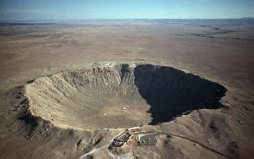THE USE OF METEORITES BY THE ANCIENT EGYPTIANS

Archeologists have found objects made from meteoritic iron in about a dozen Near Eastern localities that date from before the first millennium B.C.
Three of these are in Egypt.
| LOCATION | DATE (BC) | OBJECTS | ANALYSIS |
| Gerzeh (2 graves) | 3500-3300 | 9 Tubular Beads | 7.5% NI |
| Deir-el-Bahari (tomb) | 2050-2025 | Thin blade from amulet | Ni/Fe1/10 |
| Thebes (tomb-Tut) | 1340 | dagger blade; 16 miniature blades; model headrest |
Many are not aware that 18 items of meteoritic iron have been found in the tomb of Tutankhamen (item 3 above).
In the 1800's, Egyptologist Franz von Lauth proposed that the first iron that was worked into tools by the ancient Egyptians was of meteoritic origin. The Coptic word "banipe" (ferrum) first component "ba" he thought meant iron. Also the word "ne-pe" meant heaven and thus the word "ba-ne-pe" he said meant "metal of heaven, thus meteoritic iron.
In 1911 Wainwright discovered nine iron beads in two pre-dynastic Egyptian graves at Gerzeh, about 50 miles south of Cairo. Several years later, it was determined that they contained 7.5 percent nickel, thus of meteoritic origin.
Wainwright also said that the "Opening of the Mouth", a pre-burial ceremony, done by priests in pre-dynastic times, was done using a forked flint knife. Later in the early dynastic period this flint knife was replaced by a stone knife. Later they used a chisel called "the mdtft of biz", and that miniature ceremonial tools found in the tomb of Tutankhamen were chisel blades - replicas of the actual iron chisels employed in the rite. He suggested also that the widespread use of meteoritic iron preceded the coming of iron metallurgy. Let us quote Wainright.
"Thus, then, iron in Egypt as in many other countries was obtained from meteorites long before the Iron Age set in. Moreover, the word "biz" proves to have stood primarily for iron, or rather meteoritic material in general, whether iron, or stone, or a conglomerate of the two. From this proceed the uses to which "biz" was put by the priests, and the secondary meanings which the word took on.
" Others disagree with Wainwright's hypothesis. R. J. Forbes said that "Meteoritic iron could never be a great factor in the rise of metallurgy, for, in the absence of chemical knowledge, the connection between it and iron ores must have remained unknown. More scholars today tend to agree more with Forbes.
The Director of the Giza Pyramid Research Association, who has been a meteorite collector for years, tends to agree with Wainwright's hypothesis. We are not sure that the ancient Egyptian's did not have this chemical knowledge at that time or developed it due to the use of meteorites. Obviously, more studies need to be done and hopefully we will uncover more ancient objects in Egypt of meteoritic origin.